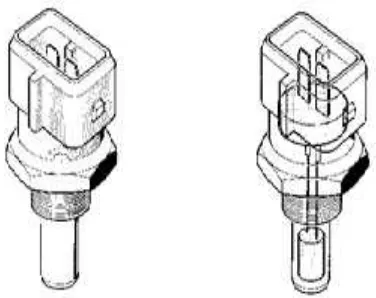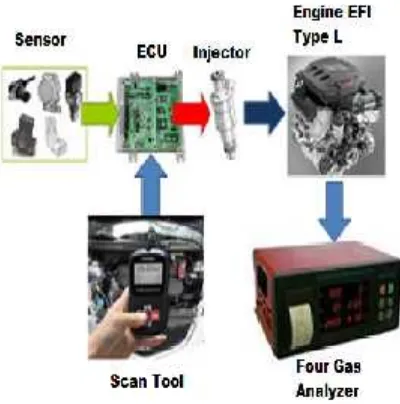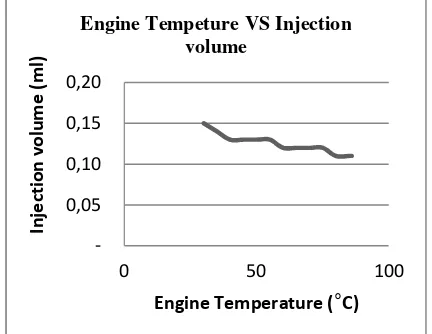Proceedings of 4th UNP International Conference on Technical and Vocation Education and Training November 09-11, 2017, Padang, Indonesia
EFFECT OF ENGINE TEMPERATURE CHANGES ON INJECTION
TIME OF FUEL AND GAS EMISSION OF GASOLINE ENGINE
Toto Sugiarto1,Dwi Sudarno Putra2, Wawan Purwanto3 Teknik Otomotif, Fakultas Teknik, Universitas Negeri Padang
[email protected], [email protected], [email protected]
ABSTRACT: This paper aims to reveal the effects of changes in engine temperature on the injection time of fuel and the exhaust gas emissions produced by gasoline motors. Engine cooling temperature is measured by engine temperature sensors sent to the computer, which will regulate the time of spraying of fuel by the injector, this will affect the exhaust gas emission content. The data of cooling water temperature change and duration of injector work were measured using scan tool, and the exhaust gas emission data was measured using four gas analyzer. The test data shows that there is a correlation between the change in engine temperature received from the engine cooling temperature sensor with the injection time of fuel spraying and the exhaust gas emission produced by the gasoline motor.
Keywords: Injection Time, Exhaust Gas Emissions, Scantool, Four Gas Analyzer
1. INTRODUCTION
Electronic fuel injection system with electronic control (Electronic Fuel Injection; EFI) uses the concept of mixing air and fuel occurs in the intake manifold by using an injector to spray the fuel in the intake manifold. The injection time pattern during spraying of fuel into the intake manifold is regulated by an Electronic Control Unit (ECU). ECU will get several sensors to spray fuel with the right amount and time according to engine speed. Comparison of the appropriate amount of fuel and air will cause perfect combustion to produce optimum power and environmentally exhaust gas emissions.
Before the engine running when the ignition switch is on, the ECU receives signals for data reads such as; cooling water temperature (ECT sensor), incoming air temperature (IAT sensor), intake pressure (MAP sensor) and throttle valve position (TP Sensor) to determine the ratio of the first gasoline-air mixture. During the engine running at start, the ECU sends the pulse to the injector based on the rpm reference pulse (engine speed). When the engine temperature is lower, the injection time pulse width is longer and there is the enrichment of the air-gasoline mixture ratio. If the engine temperatures rise, the injection time pulse width becomes shorter and the air-to-gas fuel mixture becomes thinner.
In cold engine conditions (especially low temperatures), especially in the morning, the combustion chamber requires conditioning in such
information is referred to as the conditioning determinant. What happens to this conditioning is to increase fuel injection into the combustion chamber.
The present study will reveal the relationship of changes in engine coolant temperature to the duration of fuel spraying and the exhaust gas emissions produced by gasoline motors.
2. ELECTRONIC FUEL INJECTION (EFI)
The beginning of the method of fuel entry into the combustion chamber in the 1970s to 1980 fuel intake system into the combustion chamber using carburetor system. The carburetor system mixes the air and the fuel takes place inside the carburetor. Along with the regulation of exhaust emissions, the process of mixing air and fuel has improved the regulation pattern. Beginning in the 1970s, air and fuel mixing systems gave birth to a new generation of regulatory patterns called Electronic Fuel Injection (EFI) (TTA: 2010).
Proceedings of 4th UNP International Conference on Technical and Vocation Education and Training November 09-11, 2017, Padang, Indonesia
Fig 1. Electronic Fuel Injection Scheme (EFI)
2.1 Engine Cooling Temperature Sensor (ECT)
Engine Cooling Temperature Sensor (ECT) is made of the thermistor, which is a variable resistor that is affected by temperature. ECT work is the same as IAT, just a different detection function. ECT serves to detect the engine cooling water temperature as an ECM input to correct the amount of injection of gasoline in the injector.
Fig 2. Engine Cooling Temperature Sensor ECT also serves as a temperature control engine cooling water to the driver through temperature gauge on the instrument panel. The machine
Fig 3. Graphic Characteristic of Engine Cooling Temperature Sensor
2.2 Exhaust Gass Emissions of Gasoline Engine
Gas exhaust gas is much more dangerous than the diesel motor, the gas exhaust gas is generally not visible to the eye but very dangerous for human survival.
1) The motor gasoline more dominant element of CO, HC, and Pb.
2) The diesel motor is more dominant element SO2 and Carbon element causing the density of exhaust smoke.
2.2.1 Carbon Monoxide (CO)
Carbon monoxide (CO) emissions from internal combustion motors are controlled mainly by air/fuel ratio. The maximum CO is generated when the motor operates with a mixture of greases, such as when the motor starts to be turned on in cold conditions or when accelerating. CO (Carbon monoxide) is colorless and flavorless, this gas occurs when the fuel or element C does not get enough bond with O2 means the air entering into the cylinder space is less or excessive fuel supply.
2.2.2 Hydro Carbon (HC)
Proceedings of 4th UNP International Conference on Technical and Vocation Education and Training November 09-11, 2017, Padang, Indonesia
2.2.3 Carbon Dioxide (CO2)
The higher the CO2 substance in the exhaust gas is to identify the burning in the motor. Conversely, lower levels of CO2 in the flue gas indicates that the combustion efficiency is not good and also means the engine performance is not good. Other effects: CO and HC levels rise and fuel consumption increases. CO2 levels are measured in% volume units. Average CO2 levels on motor 4 not in normal condition: motor with carburetor: 12 - 15 vol%, motor with EFI: 12 - 16 vol%, EFI motor with catalytic converter: 12 - 17% vol.
3. RESEARCH METHODS
This research uses descriptive research design. This research was conducted to describe the role of engine temperature sensors by analyzing the data obtained during the test. This research uses engine EFI type L with data collecting instruments such as thermocouple digital, engine scan tool, and four pass emission analyzer.
Testing is done in the morning when the machine is still in cold conditions. Data retrieval is
done with data retrieval scheme as shown in Figure 4.
Fig 4. Schema of Research Data Retrieval
4. RESULTS AND DISCUSSION
The data obtained is then tabulated in table 1
Table 1. Test Results on Gasoline Engine EFI Type L No
Engine Engine Injection Injection Exhaust emissions
Temperature Speed Time Volume CO HC CO2 O2
(C) (Rpm) (s) (ml) (%) (ppm) (%) (%)
1 30 1730 3,20 0,15 3,04 596 9,4 1,51
2 35 1495 2,82 0,14 1,12 235 12,7 0,75
3 40 1350 2,82 0,13 0,43 140 13,5 0,79
4 45 1234 2,82 0,13 0,41 132 13,5 0,75
5 50 1117 2,69 0,13 0,42 131 13,6 0,73
6 55 976 2,69 0,13 0,42 150 13,7 0,63
7 60 964 2,69 0,12 0,36 154 13,8 0,59
8 65 947 2,56 0,12 0,26 141 13,9 0,45
9 70 880 2,56 0,12 0,20 126 14,1 0,29
10 75 813 2,56 0,12 0,16 110 14,1 0,33
11 80 789 2,43 0,11 0,08 98 14,2 0,13
12 85 725 2,30 0,11 0,04 81 14,3 0,07
Proceedings of 4th UNP International Conference on Technical and Vocation Education and Training November 09-11, 2017, Padang, Indonesia
4.1 Engine Temperature and Injection Time
The data from table 1 then made a graph of the relationship between engine temperature and fuel injection time in order to obtain graphs as shown in Figure 5.
Fig 5. Graph of Changes in Engine Temperature to Changes Injection Time
Based on figure 5 above, there is a tendency of the relationship between engine temperature and fuel injection time on the injector. The tendency is that the higher engine temperature will increase the time of the injection.
4.2 Engine temperature and injection volume
Furthermore, from the data table 1 then made a graph of the relationship between engine temperature and the duration of injection volume of the injector to obtain graphs like Figure 6.
4.3 Engine Temperature and Exhaust Gas Emission
Based on the data from table 1 then graph of the relationship between engine temperature and exhaust gas emission of gasoline motor, which is the content of CO (Carbon Monoxide) emission and the emission content of HC (Hydro Carbon), for clarity as in graph of figure 7 and figure 8.
Fig 7. Graph of Engine Temperature on CO Emission
Based on Figure 7, there is a tendency of the relationship between engine temperature and CO content of the gasoline gas exhaust gas. The tendency is that when engine temperatures are still low the CO emissions are high, while the engine temperature is hot and reaches the ideal engine temperature (80 - 90C) the gas emission contents are small.
Engine Temperature (°C)
Engine Temperature VS Injection
Engine Temperature (°C)
Engine Temperature VS Gas
Proceedings of 4th UNP International Conference on Technical and Vocation Education and Training November 09-11, 2017, Padang, Indonesia
exhaust emissions contents are small. High levels of HC exhaust emissions in vehicles cause a foul odor from exhaust gasoline gas emissions, this happens in the morning when new vehicles are turned on.
5. CONCLUSION
The results prove that the heat of the machine detected through the cooling water temperature sensor has a relation to the time of injection time of injection time. The fuel injection time will affect the volume of the injection volume, this will affect the combustion process inside the cylinder. The longer the fuel injection time will increase the exhaust gas emission content. This is evident when the time of injection long exhaust emissions tends to be high (bad content).
6. REFERENCES
1 Daihatsu.(2010). Engine Step 1 Training. Jakarta. PT Daihatsu Astra Motor
[2] Gunadi. (2010). Effect of Ignition Timing on Car Emissions In Cars With EFI Fuel System.
Yogyakarta. Research Results At Yogyakarta State University.
[3] Hyundai. 2008. Engine and
Actuator.Hyundai.Jakarta.
[4] ImanMahir. (2007). Research methods. Padang: Papers Presented at Research Training at Scientific Research and Research Center of Universitas Negeri Padang (PPIPM UNP) 4 January 2007.
[5] JunisraSyam.(2009). EFI fuel system. Jakarta.PT. TTA International
[6] Leo priyandoko.(2009). EFI System. Jakarta.In Serving On EFI System Training in Jakarta.
7 TTA.(2010). EFI System Basics. Jakarta: PT.TTA International
8 Toyota.(2010). Training Engine Step I. Jakarta.PT. Toyota Astra Motor


